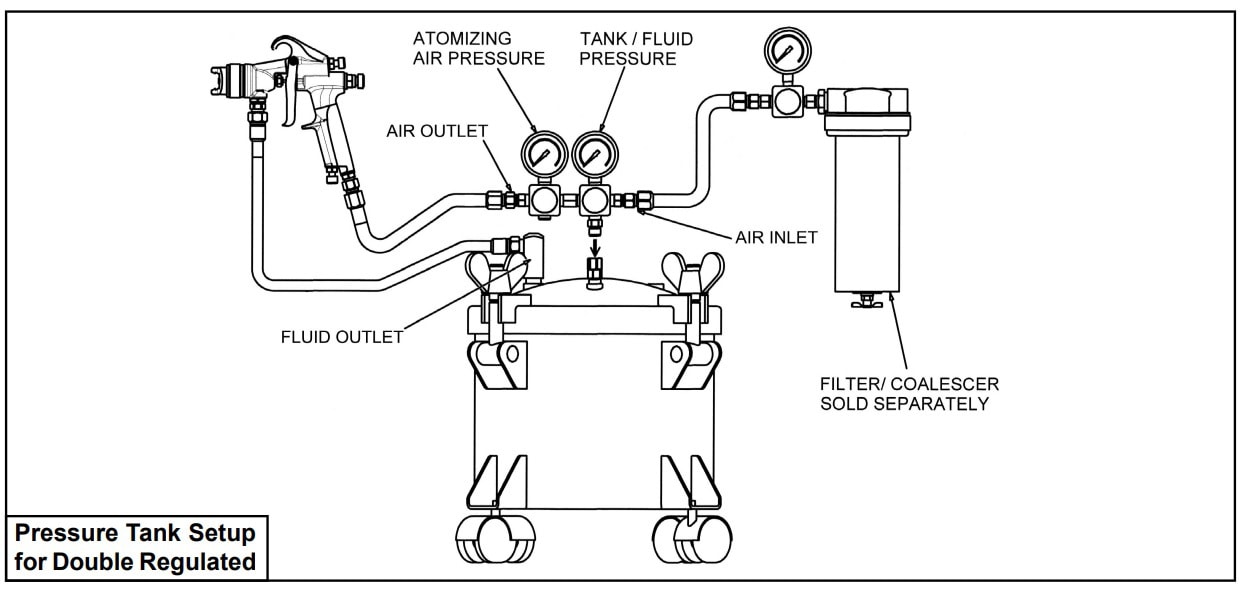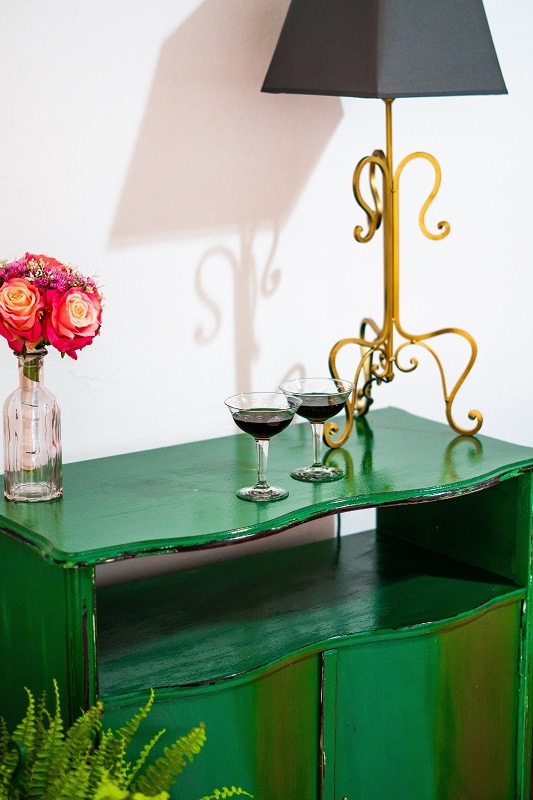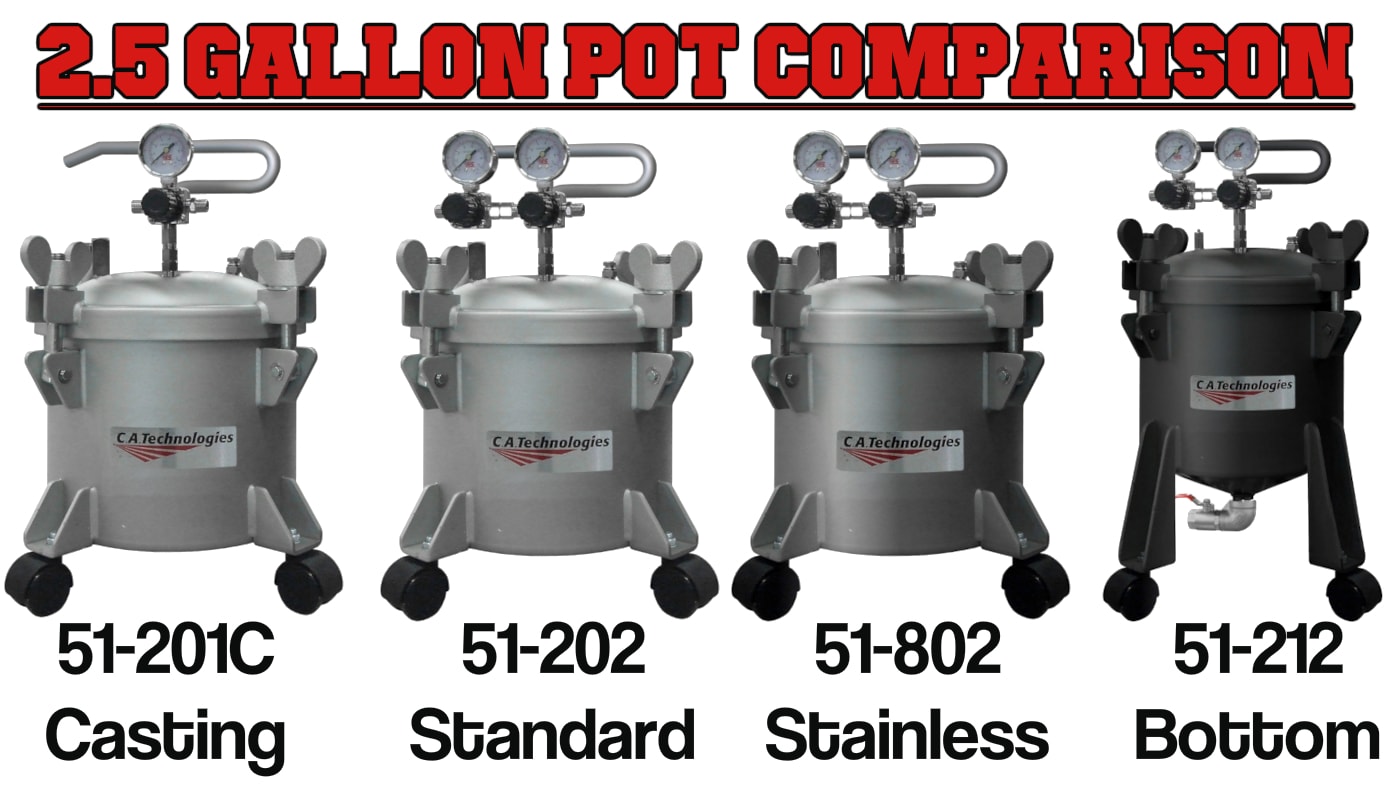Pressure Pots vs. Resin Casting Pots – How to Choose the Right Pressure Pot for my Project?
11/ 6/ 2020
How do Pressure Pots & Cast Molding Pots work?
Before going into the procedure of how a Pressure Pot or Cast Molding Pot work, let’s go over the necessary pieces in the setup we need:
- Air Compressor (cfm will be based on the gun you use; most compressors reach up to 90-100 PSI. Most of the time you won’t need that much).
- Air Regulator (1 for Casting; 2 for Pressure Pot to spray)
- Air Hose (min. 50ft. from the Air Compressor to the Air Filter for cooldown of air recommended to let air and water separate; Another hose from Air Filter to Pressure / Casting Pot)
- Air Filter (to clean the Air from decontaminants like Oil, Water & Dirt)
- Casting Mold (Cast Molding Pot only)
- More Air Hose (Pressure Pot only; from Pressure Pot to Spray Gun)
- Fluid Hose (Pressure Pot only; from Pressure Pot to Spray Gun)
- Spray Gun (Pressure Pot only) [ Read our 7 Reasons to switch from Binks to C.A. for Air-Spray guns Here].
Up until the Fluid outlet these setups work the exact same way.
The water and other contaminants in the supplied air from your air compressor will separate through cooldown in the 50 ft. hose going to the filter (3 stage filters with desiccants offer best results) where the water, oil & other contaminants will be separated from the air, providing clean air to the pressure or resin casting pot.
The clean air will now continue from the filter to your Pressure or Casting Pot to pressurize the material inside.
In a casting pot situation, you would want your mold and material already inside before pressurizing the pot, as it will have to stay clamped shut for several hours (varies based on mold & material). If you are doing resin castings, the reason why you use a casting pot is to crush the air bubbles to a microscopic size through the pressurized air coming from your compressor to the pot. You will not be able to see the tiny bubbles with the naked eye, leaving you with a beautiful crystal-clear resin casting. Make sure you leave your resin casting in the resin casting pressure pot for the full curing time.

When planning on spraying a material such as oil-based paint or stains, you want to pressurize the pressure pot after filling the pot with your paint. Your spray gun must already be hooked up to your pressure pot before turning up the air. A ball valve before and, or after the pressure pot are a great way to make this step of the setup more convenient.
The most important reminder is that the air pressure in your gun needs to be higher than the fluid pressure in your pot. For example, if your fluid pressure is at 20 PSI, your gun should be at least regulated to 21 PSI. For reference HVLP guns are up to 10 PSI at the air cap, Pressure-Reduced or Compliant typical up to 29 PSI at the inlet and Conventional above that for the best finish at the cost of lowered transfer efficiency.
What is happening here is that the first regulator in your pressure pot is controlling the air into the pot, pressurizing it in such way that the fluid will be pushed out through the outlet into a fluid hose into your spray gun. The first air regulator is also a pass-through regulator which means that unregulated air is going into the second regulator which is controlling your spray guns’ air pressure. Remember that the second regulator is optional on pressure pots, but you will need one for adjusting your spray gun air pressure.
What do Pressure Pots & Cast Molding Pots have in common?
Interestingly enough Pressure Pots & Cast Molding Pots are virtually identical with the difference that Cast Molding Pots don’t have an outlet or inlet tube.
This similarity results in the minor difference of a Casting Pot always needing only 1 regulator, while Pressure Pots for Air-Spray operate the best with 2 air regulators for fine tuning the fluid pressure and air pressure going to the gun.
Cast Molding Pots obviously will require you to have the right mold to press the material into, while pressure pots are pushing the fluid out into a fluid hose leading to your spray gun, allowing you to coat your surface.
These different applications are where the biggest gap comes from. Pressure Pots are used most of the time in woodworking shops and other industrial fabrication processes. The most typical painter with a pressure pot would be a fine finish processor of cabinets, doors and other furniture. From the base coat paint to the clear top coat satin finish. The Pressure Pot finds its best use here.
Cast Molding Pots are typically used for prototyping products, making custom pens, miniatures, action figures and other plastic or even silicone products. Even organizations like SpaceX & NASA are using these to make prototypes or parts of a finished product.
The Important Specifications to pay attention to:
The specifications you are looking for will vary based on your application, needs and budget. But let’s talk about what is important based on your basic needs.
- Capacity (Most tanks between 2.5, 5, 10, 12.5 & 15 Gallons)
- Number of Regulators (you want always 2 for best & easiest calibration)
- Agitator (most of the time it is not needed, but for some materials it might be essential)
- Outlet Position (standard is top, some are bottom, if they don’t have one then they are resin casting pots. The bottom outlet versions are only really useful for thicker materials where you need 2.2mm or bigger needle-nozzle sets)
- Liners (all C.A. Technologies Pots offer liners, except bottom outlet ones)
- Caster Wheels (for mobility, in case the pressure pot has to be moved around in the workshop)
- ASME Certification (this might become particularly important when handling explosive material or in sensitive areas, i.e. on an oil tanker; most Stainless-Steel Pots are ASME rated)
- Material (most tanks are made from heavy gage steel; more expensive ones are made with Stainless-Steel but that is often not a requirement for a great finish. But it will be necessary for water-based materials).

Which Pressure Pot is best for me?
The best way to find your perfect pressure pot is to think it through before your purchase and ask yourself the most important questions in regards to your spray gun, your workflow and your material.
How much material are you going to use in a day? For example, if you are spraying 10 gallons of paint through a pressure pot in one day, you might want one that fits the 10 gallons to prevent refilling. However, you must consider your paint, too.
Are you spraying water-based material? Then you will need a stainless steel pressure pot to prevent corrosion.
Are you spraying a lacquer with a short shelf life? Will it dry or thicken if sitting too long without use? Do you need to agitate it to keep it catalyzed if it’s a 2-part solution?
If you don’t know these properties of your your paint, they might lose their sheen, lower in quality and be more prone to orange peel.
What gun are you using? While Spray Guns are almost universally usable with any pressure pot, you will have to look at your Air Compressor to find a good match. For example, if you have only 7 cfm, you will need a Low CFM gun like the FE-LCFM from C.A. Technologies. However, you might be spraying water-based material which is relatively thick compared to stains and oil-based materials. At this point you most likely will have to upgrade your air compressor for the most ideal finish. A CPR which is adaptive between HVLP & Compliant (Pressure Reduced) is your best choice as long as you can provide it the 11-13.5 CFM @ 29 PSI it will need.
To browse all C.A. Technologies Pumps, Spray Guns, Parts & Accessories – Click Here.
Let us know on Instagram ( @jnequipment ), Facebook ( @jnequipment ) or in the comments below what your thoughts are about Pressure Pots vs. Resin Casting Pots!


